Nature Notes
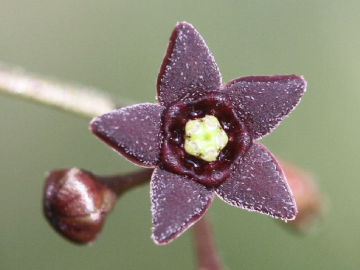
PHOTO COURTESY OF GARRY KESSLER
Black swallowwort has tiny, black flowers (about 1/3 inch).
May 16, 2025
NATURE NOTES
By Annie Reid
Westborough Community Land Trust
Spring Invasive Plant Reminder
Spring’s frenzy of renewed life is a good time to recognize invasive plants as they appear, and perhaps to prevent them from spreading and taking over your immediate surroundings. Below are six.
The future gives us a good reason to remove invasive plants or keep them in check. Climate change is likely to bring new opportunities for many invasive plants to spread farther and become more dominant. As the climate changes, the characteristics that helped these plants succeed here, far from their native environments, will probably help them adapt to changing conditions more quickly than local native plants can do. Such characteristic include: lots of seeds, early leafing out, late leaf loss, fast growth, tolerance for various soil and weather conditions, and absence of diseases and pests that controlled them in their own native environments.
Black swallowwort (Cynanchum louiseae) is a relatively new invasive plant in our region. This twining vine grows rapidly. Look for tiny, black, star-shaped flowers (about 1/3 inch, five petals). Its pointed, oval leaves grow in pairs. It’s related to milkweeds, and like them, has milky sap. In summer, its long seedpods release seeds that fly on the wind with silky hairs, like milkweed seeds do.
Black swallowwort can mean trouble for Monarch butterflies, which normally lay eggs on common milkweed (Asclepias syriaca). These butterflies will also lay eggs on this rapidly proliferating vine. The problem? Monarch caterpillars don’t survive on black swallowwort. Spot this invasive vine early and pull it out.
Two well-publicized invasive plants, garlic mustard and purple loosestrife, are easier to remove as they first come up than in their later, familiar blooming stages.
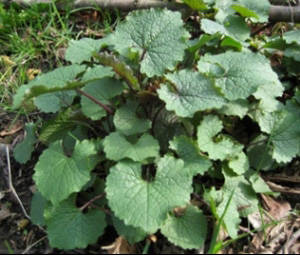
Garlic mustard in its first year, before it blooms in its second year
Garlic mustard (Alliaria petiolate, more) plants live for two years. Spring is a good time to recognize first-year plants and pull them up. Look for low mounds of rounded, heart-shaped leaves, which often remain green in winter. In May, the second-year plants bloom (May) with white flowers and will go to seed and die by the end of June.
A good reason for removing garlic mustard from an area is that its roots release toxic chemicals that change the soil, making it harder for other plants to grow. These chemicals disturb the beneficial mycorrhizal (fungus-root) relationship between plant roots and underground fungi. This relationship is important to more than 80 percent of land plants. Garlic mustard is among the 20 percent that don’t use such a relationship.)
Garlic mustard is also is considered a long-term threat to hardwood forests. Why? Our white-tailed deer avoid eating stands of garlic mustard, which they don’t like, and instead feed heavily on native plants, including tree seedlings that represent the future of the forest.
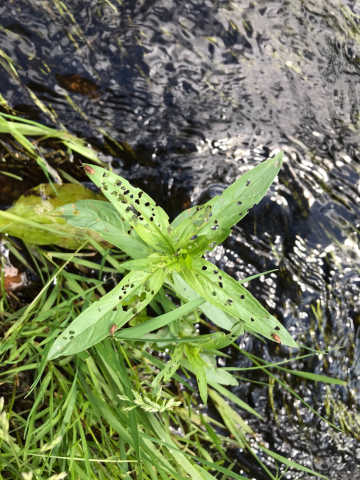
Purple loosestrife plant coming up in May, with holes from the munching of Galerucella biocontrol beetles (seen here on leaf tips)
Purple loosestrife (Lythrum salicaria, more) plants live for many years, coming up year after year and taking over wetlands. They bloom in late July and August and produce vast numbers of seeds that spread by water and wind. In May, look for purple loosestrife plants as they come up in sunny, damp, bare or disturbed soil at the edges of streams, ponds, drainage basins, and wet areas. You might even notice a good sign: holes in the leaves. The holes are typical signs of munching by the caterpillar and adult stages of purple loosestrife beetles (Galerucella). These beetles were introduced throughout eastern Mass about 15 years ago as a biocontrol agent to help control purple loosestrife. You might also spot some adult beetles (see our photo). Deer do nibble the plant, but they prefer native plants.
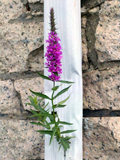
PHOTO COURTESY OF MARGE FISHER
Purple loosestrife growing out of a downspout.
Among the many other invasive plants have become fixtures in our landscape are two that bloom around the same time in May: autumn olive shrubs and Asian bush honeysuckles.
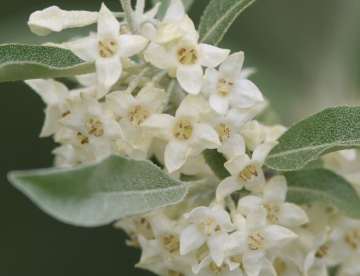
PHOTO COURTESY OF GARRY KESSLER
Autumn olive blossoms in May
In May, a sweet, somewhat heavy fragrance in the air is a clue that the invasive shrub, autumn olive (Elaeagnus umbellate, more), is nearby. Look around for its silvery, gray-green foliage and its multitude of small, creamy yellow-white blossoms. These drought-resistant shrubs grow tall and wide and can thrive in many conditions, including poor soil. They were once planted along our highways. Far from their original habitats in Asia, they do “too well” here and tend to take over and shade out other plants. In fall, notice the branches heavy with fruit (not olives!). The pea-sized red berries flecked with silver are popular with birds, and some people like to eat them.
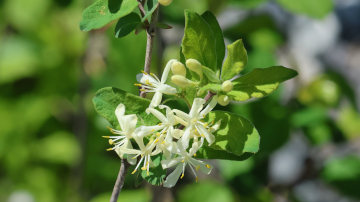
PHOTO COURTESY OF GARRY KESSLER
Bush honeysuckle flowers, white but turning yellow with age
If you’ve noticed wild shrubs leafing out early (say, in April, before most other vegetation), you might have seen invasive Asian bush honeysuckles. They’re often so well established that we take them for granted. Common in our region are Morrow’s honeysuckle (Lonicera morrowii), Bell’s honeysuckle (Lonicera x Bella), and hybrids. Bush honeysuckles bloom now (May-June), so look for the white flowers (turning yellow with age) or pink flowers. In summer, notice red berries that attract birds, which then spread the seeds. These shrubs can grow more than 10 feet tall. They spread easily to dominate woods, roadsides, fields, and woodland edges. They shade or crowd out other plants.
Asian bush honeysuckle leaves are opposite one another. On older stems, the bark is shaggy. The stems are hollow, unlike native honeysuckle stems which are solid inside. One native example is American fly honeysuckle (Lonicera canadensis), common in western Massachusetts.

PHOTO COURTESY OF GARRY KESSLER
Wild multiflora rose blooms all around us in June.
In June, it’s hard to miss multiflora rose (Rosa multiflora, “many-flowered rose,” more). This invasive wild white rose has thorny stems and cascades of small white flowers. It seems to be everywhere and anywhere. It forms dense, thorny thickets and outcompetes other plants. In September, notice the red, oval, berry-like rose hips containing its seeds. Birds like them and spread the seeds wide and far. If you find a small stem of this rose starting to grow in your area, grab heavy garden gloves and pull it out before it gets established.
Our region has many other invasive plants, including Asian bittersweet, Japanese knotweed, burning bush, common barberry. Norway maple, and border privet.
For more information about removing invasive plants on a larger scale, check the “Solutions” section for each invasive plant listed in this Mass Audubon article.